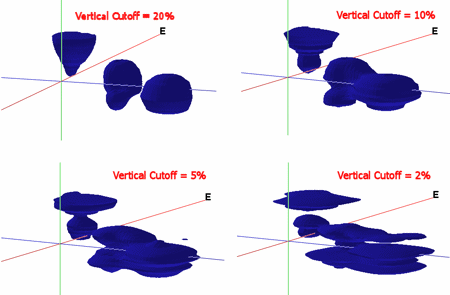The Horizontal Biasing method of solid modeling uses Inverse-Distance modeling, in which the value of each of the data points is weighted according to the inverse of its distance from the voxel node being computed, taken to a user-selected power. The difference with Horizontal Biasing is that the user can define a vertical distance from each voxel node beyond which points will no longer be used in computing the node value. This allows the user to horizontally bias the interpolation process such that stratiform deposits such as sand and gravel may be modeled more effectively.
Advantages: This method has the same advantages as the Inverse-Distance modeling AND permits you to introduce an elevation bias to the modeling procedure.
Disadvantages: Horizontal Biasing will make the modeling process more localized.
- Percentage-Based (% of Project Size): Choose this option if you want to specify the distance as a percent of the project size. Expand this heading to establish the distance settings.
- Vertical Cutoff: Enter the distance above and below the solid model voxel node beyond which data points will not influence its value. For this grouping, the distance is expressed as a percent of the size of the project. In these examples, the horizontal cutoff is a constant 10%, and the vertical cutoff decreases from 20% to 2%:
-

- Horizontal Cutoff: Enter here the horizontal distance from the voxel nodes, as a percent of your project size, beyond which data points will not influence the node value. The program will search this radius for control points within the vertical cutoff zone declared above. When applied with the vertical cutoff, this can really localize the node interpolation. Beware of making this distance too small, or you will get many localized “donuts".
- Absolute (Cutoffs Expressed in Map Units): Choose this option if you want to specify the cutoff distances in map units (e.g. feet or meters). Expand this heading to enter the distance settings. The caveats listed above also apply here.
- Vertical Cutoff: Enter the vertical distance beyond which data points will not influence a node's value, using your depth units (feet or meters).
- Horizontal Cutoff: Enter the distance from the voxel nodes, in your X (Easting) and Y (Northing) units, beyond which data points will not influence the node value.
If you establish vertical and horizontal cutoff distances that result in some voxels having no control points to draw from for G value interpolation, the program will assign the node the value entered under the Undefined Node Values setting at the bottom of the Solid Modeling Options window.
 Back to Solid Modeling Method Summary
Back to Solid Modeling Method Summary

RockWare home page

